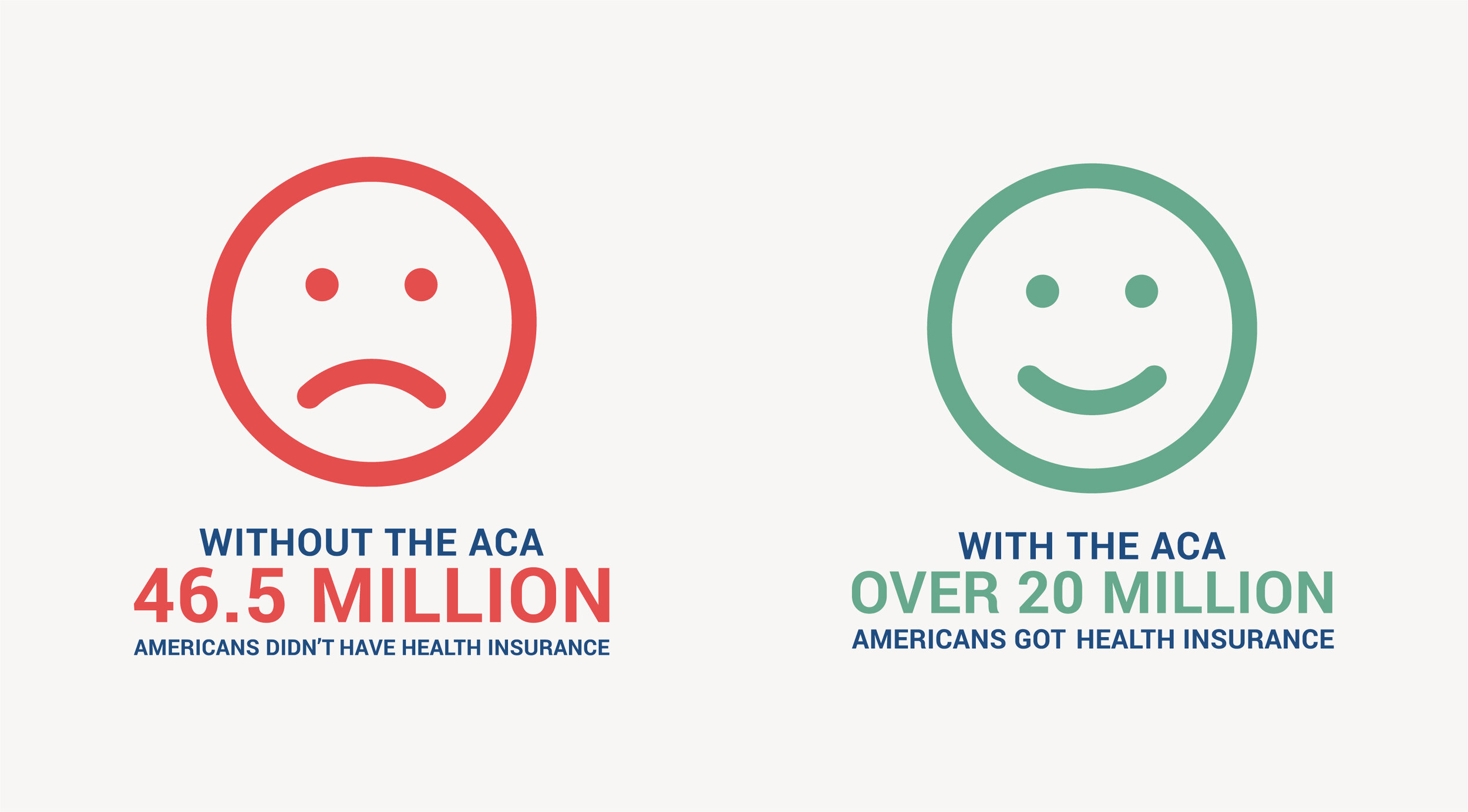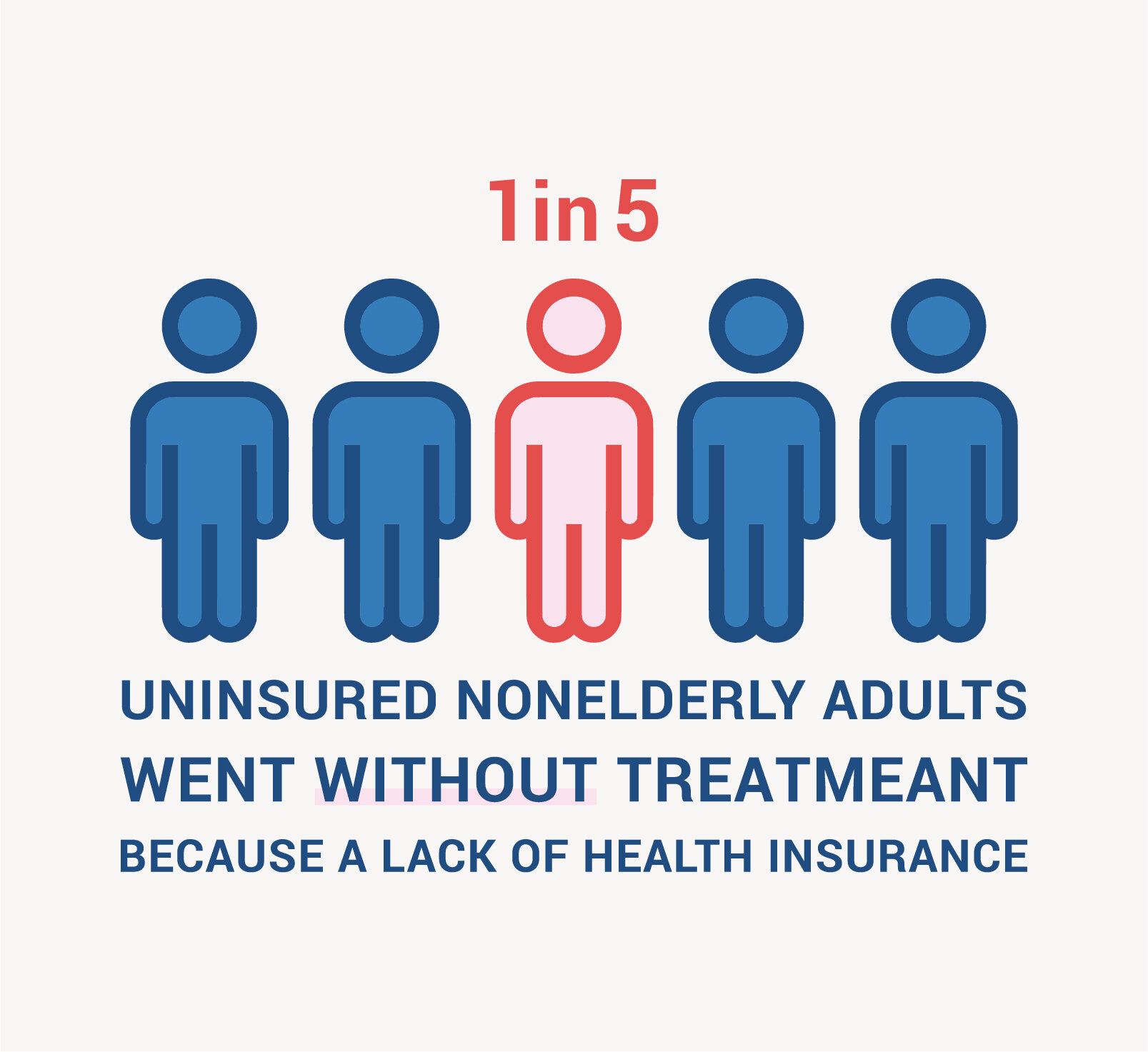
Healthcare
Biden’s Healthcare Policy

Healthcare in America
The COVID-19 pandemic has exposed the fragility of the United States’ health insurance system. Over 156 million Americans depend on their employers for healthcare – when the pandemic hit, 5.4 million Americans lost access to health insurance at the most crucial time to have it. Access to affordable healthcare, however, is not a new problem. When the Obama Administration passed the Affordable Care Act in 2010, it was the first major healthcare reform since the expansion of Medicare and Medicaid coverage in 1965. The Affordable Care Act (ACA) expanded healthcare coverage to millions, protected those with pre-existing conditions, and sought to make healthcare more affordable.
The Biden Administration will use the ACA as a foundation to expand healthcare coverage even further with a goal to insure 97% of Americans. The current administration has vowed to “repeal and replace” the Affordable Care Act with a different semi-national healthcare plan. So far, they have not been able to articulate or implement another healthcare plan.
Good, quality healthcare is a necessity and Joe Biden is committed to creating a health insurance system that is affordable and works for all Americans.
THE AFFORDABLE CARE ACT
The Affordable Care Act helped significantly lower the number of Americans without health insurance. According to the Kaiser Family Foundation, “prior to the Affordable Care Act, gaps in the public insurance system and lack of access to affordable private insurance left millions without health insurance.”
Source: Tolbert, J., Orgera, K., Singer, N., & Damico, A. (2019, December 13). Key Facts about the Uninsured Population. Kaiser Family Foundation. Retrieved from https://www.kff.org/uninsured/issue-brief/key-facts-about-the-uninsured-population/
Estimates indicate that prior to ACA, there were between 44 to 46.5 million Americans without health insurance coverage because they “did not fit into any existing payment streams,” “were simply unable to find affordable insurance” or “because they had a pre-existing condition” (Berwick).
Healthcare reform was a signature issue of the Obama Administration; President Obama signed the Affordable Care Act into law in 2010. It focused on improving access to health insurance and closing the uninsured gap in a variety of ways. The ACA has helped over 20 million previously uninsured Americans get healthcare coverage.
— Introduced an individual mandate requiring all Americans to be insured or pay a tax penalty if they remained uninsured.
— Allows young people to remain on their parent’s health insurance policy until they turn 26.
— Protects those with pre-existing conditions from being denied health insurance coverage.
— Expands Medicaid coverage to anyone making 138% of the federal poverty line or less.
— Makes comparing health insurance options easier through a national health insurance marketplace.
— Provides federal subsidies for health insurance to Americans making 138% to 400% of the federal poverty line.
Why it’s necessary to expand the ACA
Health insurance reform is still needed in the United States, because the Affordable Care Act did not go far enough to increase health insurance access, reduce healthcare costs, and increase market competition for private health insurance companies.
Additionally, since the passage of the Affordable Care Act, republicans have been doing everything possible to try to dismantle, strip down or repeal it. In June 2012, the Supreme Court ruled that the ACA’s Medicaid expansion provision was optional for states. In December 2017, the ACA individual mandate was repealed as part of the Tax Cuts and Jobs Act.
Reforming healthcare by building on and expanding the Affordable Care Act is crucial because approximately 30 million Americans still do not have health insurance, there is still a Medicaid coverage gap, and health insurance premiums are still too expensive and have gone up in the past few years.
Some Americans Are Still Uninsured
While the Affordable Care Act did significantly reduce the number of Americans without coverage, there are still many Americans without health insurance. Research estimates that in 2018 between 27.9 and 30.1 million Americans did not have health insurance (Kaiser Family Foundation; CDC). Biden believes that access to healthcare is a right and that we must reform our healthcare system so that all Americans have access to affordable and reliable health insurance coverage.
Source: Tolbert, J., Orgera, K., Singer, N., & Damico, A. (2019, December 13). Key Facts about the Uninsured Population. Kaiser Family Foundation. Retrieved from https://www.kff.org/uninsured/issue-brief/key-facts-about-the-uninsured-population/
Having health insurance is important, because Americans who do not have health insurance tend to have more limited access to healthcare services and often go without needed preventive care.
In fact, research from 2018 shows that one in five uninsured nonelderly adults went without necessary medical treatment. Biden’s healthcare plan will build on the Affordable Care Act and will help provide health insurance coverage to an estimated 97% of Americans.
Medicaid Coverage Gap
The Affordable Care Act extended Medicaid eligibility to include low-income individuals and families at or below the 138% federal poverty line. In 2020, an individual making $17,236 or below or a family of four making $36,156 or below would be eligible for Medicaid coverage. This Medicaid expansion was designed to help fill the historic coverage gaps to extend Medicaid coverage to nearly all low-income Americans.
Source: Garfield, R., Orgera, K., & Damico, A. (2020, January 14). The Coverage Gap: Uninsured Poor Adults in States that Do Not Expand Medicaid. Kaiser Family Foundation. Retrieved from https://www.kff.org/medicaid/issue-brief/the-coverage-gap-uninsured-poor-adults-in-states-that-do-not-expand-medicaid/
In June 2012, however, the Supreme Court ruled that this Medicaid expansion provision was optional for states and as of January 2020, there are still 14 states that have not expanded their Medicaid eligibility coverage. This makes it more difficult for low-income Americans to get the health insurance coverage they need. In fact the Kaiser Family Foundation, found that “most people who are uninsured are nonelderly adults, in working families, and in families with low incomes.”
Premiums Are Still Too Expensive
➪ A study by the Kaiser Family Foundation found that those who are currently uninsured cite high premium cost as the primary prohibiting factor that is stopping them from getting healthcare coverage, which is a critical problem facing the ACA.
This study explains that “large increases in premiums in the individual market in 2017 and 2018 made coverage much less affordable.”
Health insurance premiums are a cost burden for even those who do have health insurance, especially those who do not qualify for a premium tax credit. In 2020, the average American individual using the ACA Marketplace to purchase insurance paid $4,450 in premiums (Kaiser Family Foundation). Biden’s healthcare plan will lower insurance premiums by creating a public option and provide enhanced tax credits to help individuals and families with their health insurance premium payments.
Biden’s Healthcare Proposed Policies
Health insurance reform is still needed in the United States, because the Affordable Care Act did not go far enough to increase health insurance access or reduce healthcare costs for Americans. According to Biden’s website,
Source: Health Care. Retrieved from Joe Biden for President: Official Campaign Website: https://joebiden.com/healthcare/#
“Instead of starting from scratch and getting rid of private insurance, he has a plan to build on the Affordable Care Act by giving Americans more choice, reducing health care costs, and making our health care system less complex to navigate.”
He will give Americans more choices for health insurance providers by building on the ACA. It is estimated that under Biden’s plan, 97% of Americans would have health insurance coverage. Let’s dive in and see exactly what Biden is planning to do to improve access to healthcare and lower healthcare costs in America.
1. Create A Public Option
Biden will create a public health insurance option available to all Americans. The public option insurance plans would be available on the ACA Marketplace alongside other plans from private health insurance companies.
→ The public option would be a choice – no one would be forced off of their current insurance plan or required to buy a public option insurance plan. Individuals and families could use their government-issued health insurance tax credits to buy an insurance plan from either a private health insurance provider or the public option insurance provider. Having a public option insurance provider would give people more choices, not less.
➪
Creating a public option insurance provider would bring down health insurance premium costs by creating more competition in the private health insurance market.
Currently, the U.S. private health insurance market is very concentrated with a few large private health insurance companies dominating the market and yielding enormous market power. A United States Government Accountability Office report found that between 2011 and 2016 the three largest private health insurance companies controlled 80% or more of the private health insurance market in at least 37 states, and this market consolidation has only gotten worse in recent years.
This lack of competition allows private health insurers to charge high premiums, offer limited coverage and customer benefits, and utilize inefficient business practices. Efficiency and enhanced customer service and benefits are not incentives to companies that have immense market power.
A study by the American Medical Association found that major health insurance companies have been using their market power to raise premium prices in order increase company revenues, but they often do this without providing customers with enhanced coverage or benefits in return. Many believe that government regulation alone is not enough to effectively regulate and increase competition in the private health insurance market, but rather the market needs to be reformed by creating a new health insurance option for consumers – a public option.
Creating a public option will infuse healthy competition into the private insurance market, which will lower premium prices, increase efficiency and enhance coverage benefits.
As Jacob Hacker, the Director of Yale University’s Institute for Social and Policy Studies explains: “most Americans want public and private insurance companies competing side by side so that they can choose the best option for themselves and their families.”
Allowing public and private insurance plans to compete side-by-side will help to bring down premium cost and increase coverage benefits, while letting Americans choose the best plan for themselves and their families. A report published by Georgetown University Center on Health Insurance Reforms explains that “competition among insurers helps keep prices low and can provide expanded choices for consumers.”
→ Unlike single-payer healthcare proposals, creating a public option will not dismantle the private health insurance market, which provides thousands of American jobs. Instead having a public option will restore healthy competition into the health insurance market and incentivize private health insurance companies to be more efficient and effective.
Biden knows that fiscally it does not make sense to eliminate private health insurance, instead he believes that we need to reform the private insurance market by creating a public option that will increase choice and reduce costs for health insurance plans. Biden also knows that creating a public option will help the United States get closer to achieving universal health insurance coverage by increasing coverage options, especially for those who live in rural areas, and improving affordability for everyone.
…WHAT’S THE DIFFERENCE BETWEEN THE PUBLIC OPTION
& A SINGLE-PAYER HEALTHCARE SYSTEM??
→ A single-payer system is a completely government run health insurance system under which all citizens are covered
→ A public option is a federal health insurance provider that would compete with private insurance companies and would have a variety of health insurance plans available on the ACA marketplace.
2. Add Extra Benefits to the ACA Marketplace
Biden’s healthcare plan will increase the value of health insurance tax credits by changing the way these tax credits are calculated and eliminating the income eligibility cap. Currently, Americans that make between 138% and 400% of the federal poverty line receive a tax credit to use on the ACA Marketplace to purchase insurance if they are not offered “affordable insurance” by their employer. For 2020, “affordable insurance” is considered by the IRS to be 9.78% of household income. Biden’s plan decreases this threshold to 8.5% and eliminates the 400% federal poverty line income cap to qualify for the tax credit. Individuals and families could use the tax credits to buy an insurance plan on the ACA Marketplace from either a private health insurance provider or the public option insurance provider.
This means that no American, regardless of income, will have to spend more than 8.5% of their household income on health insurance coverage. Under Biden’s plan, these tax credits will also now be calculated based on the costs of the “gold” insurance plans - the best health insurance plans that provide the most coverage. If the gold insurance plan costs more than 8.5% of their household income, Americans would receive a tax credit that subsidizes the remaining balance.
3. Lower Medicare Age
Biden’s healthcare plan would lower the eligibility age for Medicare from 65 to 60. This would allow 20 million Americans to become new beneficiaries of Medicare health insurance plans. This component of Biden’s healthcare plan would be very simple to implement, since the Medicare infrastructure is already established and all that would change is the eligibility age.
Decreasing the Medicare age eligibility to 60 would move some people from Medicaid to Medicare, which would relieve states of some of the financial burden of the increased Medicaid enrollment since the beginning of the COVID-19 pandemic.
Decreasing the Medicare eligibility age would also significantly benefit early retirees and older Americans who are out of work but had been relying on their employer’s plan for health insurance coverage.
Source: Health Care. Retrieved from Joe Biden for President: Official Campaign Website: https://joebiden.com/healthcare/#
4. Close the Medicaid Coverage Gap
→ Medicaid is a public health insurance program for low-income individuals. Medicaid is jointly funded by federal and state governments, but is managed by individual states, who establish eligibility requirements.
The Affordable Care Act extended Medicaid eligibility to include low-income individuals and families at or below the 138% federal poverty line, but in June 2012 the Supreme Court ruled that this Medicaid expansion provision was optional for states, this expansion provision has left out 4.9 million low-income Americans. These Americans should be eligible for health insurance under Medicaid coverage, and would be covered if they lived in a different state.
Biden’s healthcare plan will offer federally funded, premium-free access to the public option health insurance plans for these Americans. This will ensure all American adults with low incomes have health insurance and are able to get the healthcare they need. States that have expanded Medicaid under the ACA could allow Medicaid expansion recipients to be covered by the public option plan as long as they continue to fund their share of coverage costs.
5. Reform Prescription Drug Market
Big pharmaceutical companies have been making large profits off of the inefficiencies in the American healthcare system.
In 2018, Americans spent $535 billion on prescription drugs, which is a 50% increase from 2010.
The current administration has vowed to stand up to the pharmaceutical industry and lower drug costs for Americans for the past four years. But nothing has been done – in fact, prescription drugs have continued to outpace inflation 9% to 2%.
Joe Biden’s plan will work to reduce drug prices and protect Americans who rely on medication to live happy and healthy lives. Biden’s plan repeals the law that forbids Medicare from negotiating lower drug prices. This will save taxpayers money and prohibit large pharmaceutical companies from setting high prices because of the large purchasing power of Medicare. Additionally, Biden will regulate prices on new drugs by creating an independent review board to recommend a fair price that Medicare and Medicaid will pay.
For drugs to be offered through Medicare and Medicaid, they will be required to keep price increases consistent with the rate of inflation or lower. Biden will also encourage competition by allowing Americans to buy FDA-approved pharmaceuticals abroad and promote the development of safe generics. In 2016, pharmaceutical companies spent over $6 billion on advertising and got to deduct these costs on their taxes. Biden will prohibit drug corporations from deducting advertising expenses from their taxable income, which will help to disincentivize excessive advertising spending.
Paying for Biden’s Healthcare Plan
Biden’s healthcare plan is estimated to cost $750 billion over the next ten years. Biden plans to pay for this healthcare plan by raising the tax rate on long-term capital gains and reforming the way inheritance is taxed.
He plans to add a 39.6% capital gains tax bracket for those earn over $1 million per year, so that the wealthiest Americans pay the same tax rate on the profits from their investments as they do on their regular income.
Biden’s plan will also eliminate the step-up basis rule that allows wealth to pass through generations at greatly reduced tax rates. Under current tax law, when an asset is inherited, it’s cost-basis is adjusted to the value of the asset at the time of death, rather than at the time of purchase. Under Biden’s plan, inherited assets will maintain their cost-basis, so that when they are sold by the beneficiary, the full value of the asset’s appreciation is taxed. According to the United States Congress’ Joint Committee on Taxation in the 2021 fiscal year, the exclusion of capital gains at death is a $43.8 billion tax expenditure.
The Urban Institute & Brookings Intuition’s Tax Policy Center estimates that raising the capital gains tax on the wealthiest Americans and removing the step-up basis will bring in $447.6 billion in additional Federal revenue between 2021 and 2030 and $817.6 billion in additional Federal revenue between 2031 and 2040.






